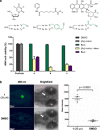Gold-Triggered Uncaging Chemistry in Living Systems
- PMID: 28699691
- PMCID: PMC5655737
- DOI: 10.1002/anie.201705609
Gold-Triggered Uncaging Chemistry in Living Systems
Abstract
Recent advances in bioorthogonal catalysis are increasing the capacity of researchers to manipulate the fate of molecules in complex biological systems. A bioorthogonal uncaging strategy is presented, which is triggered by heterogeneous gold catalysis and facilitates the activation of a structurally diverse range of therapeutics in cancer cell culture. Furthermore, this solid-supported catalytic system enabled locally controlled release of a fluorescent dye into the brain of a zebrafish for the first time, offering a novel way to modulate the activity of bioorthogonal reagents in the most fragile and complex organs.
Keywords: bioorthogonal; fluorescent probes; gold; heterogeneous catalysis; prodrugs.
© 2017 Wiley-VCH Verlag GmbH & Co. KGaA, Weinheim.
Conflict of interest statement
The authors declare that compounds
Figures




References
-
- None
-
- Streu C., Meggers E., Angew. Chem. Int. Ed. 2006, 45, 5645–5648; - PubMed
- Angew. Chem. 2006, 118, 5773–5776;
-
- Yusop R. M., Unciti-Broceta A., Johansson E. M. V., Sánchez-Martín R. M., Bradley M., Nat. Chem. 2011, 3, 239–243. - PubMed
-
- None
-
- Unciti-Broceta A., Johansson E. M. V., Yusop R. M., Sánchez-Martín R. M., Bradley M., Nat. Protoc. 2012, 7, 1207–1218; - PubMed
Publication types
MeSH terms
Substances
Grants and funding
LinkOut - more resources
Full Text Sources
Other Literature Sources

